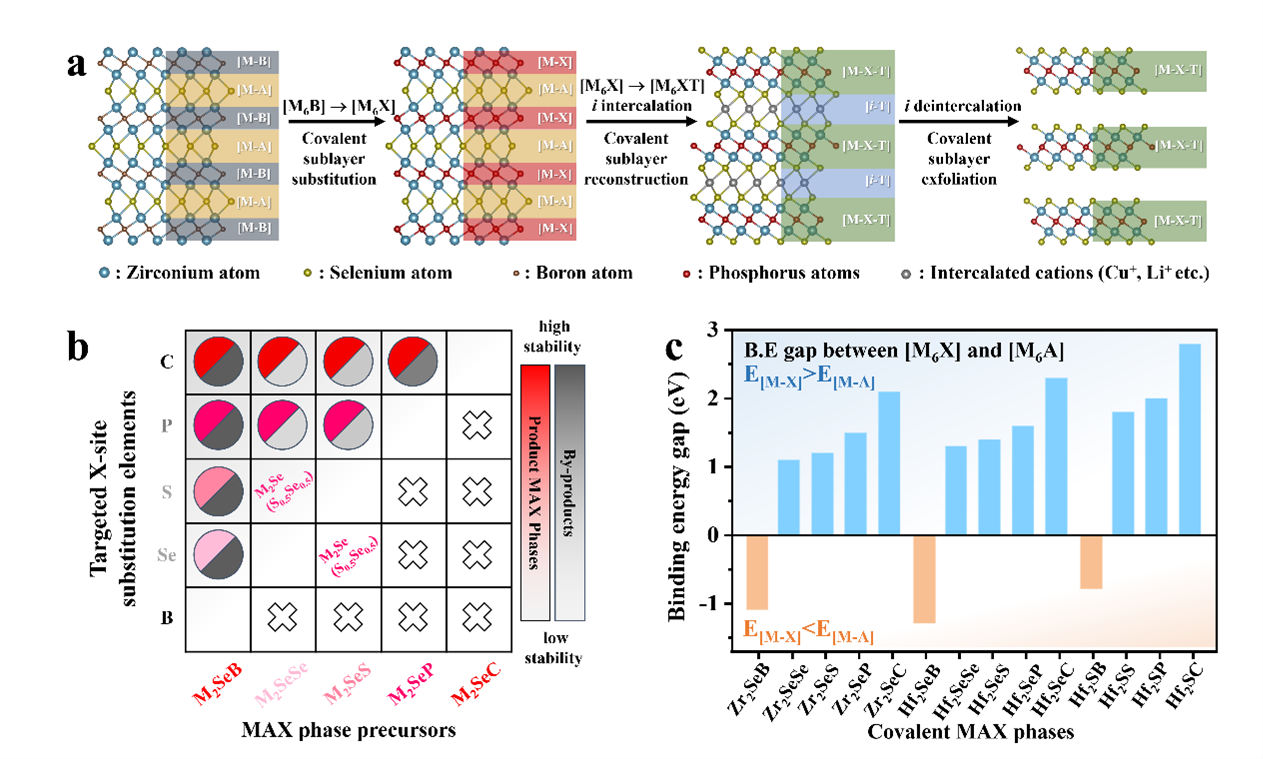A research team led by Prof. HUANG Qing from the Ningbo Institute of Materials Technology and Engineering (NIMTE) of the Chinese Academy of Sciences has developed a new way to "edit" the internal layers of certain advanced materials, called MAX phases, in a breakthrough that could lead to entirely new kinds of two-dimensional (2D) layered materials with valuable technological uses.
MAX phases get their name from their general chemical formula, Mn+1AXn, where M is an early transition metal like titanium, A is a main-group element like aluminum or silicon, and X is carbon or nitrogen. The name is significant because it reflects the layered structure of these materials: sheets of strong metal-carbon/nitrogen layers interleaved with more weakly bonded "A" layers. This layered nature is what makes them promising starting points for producing 2D materials.
These 2D materials, which are only a few atoms thick, are attracting enormous interest for their potential in applications such as batteries, catalysts, and shielding against electromagnetic interference, due to their tunable elemental compositions and surface terminations. One well-known group of 2D materials, called MXenes, is usually made by chemically removing certain atoms from MAX phase crystals. This process, known as "etching," uses hydrofluoric acid or Lewis-acidic molten salts to selectively remove metallic A-site atoms such as aluminum and silicon.
However, some members of the MAX phase family exhibit strongly covalent sublayers where non-metallic main-group elements (e.g., oxygen, sulfur, selenium, and other chalcogens; and nitrogen, phosphorus, arsenic, and other pnictogens) occupy the A sites. In these covalent MAX phases, the coexisting covalent character of both M-A and M-X bonds prevents traditional etching methods from removing the non-metallic A-site atoms, thereby hindering their conversion into 2D MXenes.
In this study, published in Nature Synthesis, the researchers uncovered significant differences in the chemical reactivity between the distinct covalent sublayers within MAX phase crystal structures. By exploiting this chemical disparity, the team achieved selective structural editing of both M-A and M-X covalent sublayers in MAX phases, subsequently obtaining a series of novel layered inorganic materials and 2D nanomaterials through ion intercalation.
The researchers discovered that precisely controlling the total formation enthalpy of a well-designed reaction with a targeted sublayer enables the targeted replacement of the X site with non-metal elements (e.g., from B to Se, S, P, and C).
Meanwhile, Lewis acidic cations can reduce the M-element oxidation state in M-X sublayers, facilitating additional non-metal (e.g., S/Se) attachment. This also enables the transformation of non-van der Waals MAX phases into van der Waals layered materials.
Using these structural editing strategies, the researchers successfully synthesized a new class of 2D materials, which they termed early transition metal chalcogenide carbides/nitrides (TMXC). These TMXC lattices combine hallmark features of MXenes and transition metal dichalcogenides (TMDs), with X elements including C, N, B, P, S, and Se.
Both theoretical calculations and experimental results demonstrate that editing the X-element in the M-X covalent sublayer effectively modulates the intrinsic electronic structure of the MAX-derived 2D TMXCs.
This work pioneers a new pathway for the structural editing and 2D exfoliation of covalent-bonded ternary layered compounds, with promising applications in high-temperature electrochemical energy storage devices and catalysis.
This study was supported by the National Natural Science Foundation of China and the Ningbo Young Scientific and Technological Innovation Leading Talent Project, among others.

Structural editing strategy from covalent MAX phase to TMXC. (Image by NIMTE)






